Once a suburb thriving with amenities, Whitehaven is saddled with outside perceptions that the neighborhood is poor because its demographics flipped from white to black. Its native retailers, like Southland Mall (the oldest operating mall in Memphis), know the advantage of adapting to a changing audience — even as big-box names are drawn across the border to Southaven, Mississippi.
One day it was there, and the next day there was a note on the door announcing that Red Lobster was closed.
When the sit-down restaurant closed in the late 1990s, it marked a turn in Whitehaven’s retail landscape as other large chains began to move across the state line to Southaven, Mississippi, which is a 10-minute drive away from the South Memphis suburb.
As residents drive over the state line and continue to patronize some of their favorite stores and restaurants, many of which were once anchors in their own neighborhood, they still have concerns about the effect that white flight had on the presence of amenities, particularly sit-down restaurants.
The remaining businesses and developers work to cater to the new demographic and look towards the future.
The Resident: White Flight and Lost Amenities
A resident of Whitehaven for the past 30 years, Howard Robertson said that he patronizes businesses in Southaven “begrudgingly” because the stores are close and convenient to him, and the Southaven sales tax, at seven percent, is lower than Memphis’ sales tax of 9.25 percent.
Robertson, co-founder of Memphis-based Trust Marketing & Communications,was drawn to Whitehaven from Midtown in 1986. He wanted a larger home for his family, and Whitehaven boasted sizeable single-family homes and abundant neighborhood amenities.
“Every kind of amenity that you typically see in predominately Caucasian neighborhoods was here. You could go up on Elvis Presley [Boulevard] and do anything you needed to do and find anything you needed to find,” Robertson said.
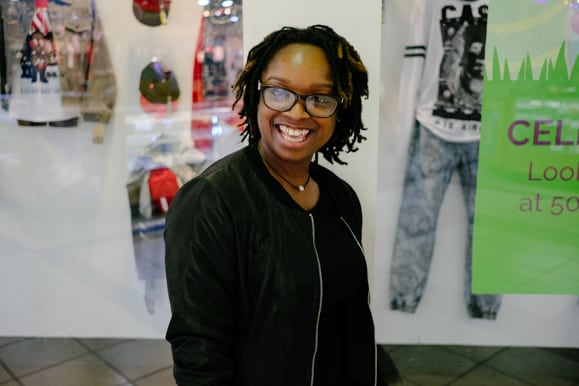 “Hey, take my picture.” A spontaneous portrait inside Southland Mall. (Brandon Dahlberg)
“Hey, take my picture.” A spontaneous portrait inside Southland Mall. (Brandon Dahlberg)
But, as the demographics of the neighborhood shifted, so did the amenities.
By 2000, the population for ZIP 38116, which covers Whitehaven, came in at 51,000 residents and 91 percent of residents were black.
According to a 1999 article from the New York Times, “Memphis blacks find poverty’s grip strong,” Red Lobster was not the only retailer that closed in the late 1990s. Whitehaven also lost a Chrysler-Plymouth dealer and a Target.
“African-American growth had taken off to the point that I was shocked when a friend of mine told me it was nicknamed Blackhaven.”
Robertson said that changes in the neighborhood amenities over the past 30 years have been significant, and those losses shaped the perception that Whitehaven is not an affluent community.
“Unfortunately, when communities change in terms of their racial makeup, when they go from predominantly white to predominantly black, the perception is that it has gone from well-off to poor. This is seen not just in Whitehaven, but across the city,” Robertson said.
Robertson said when he and his family arrived in Whitehaven, it was among the highest in the state of Tennessee in a number of categories such as home values, the number of college graduates and average household incomes.
There are nearly 15,000 households in 38116. The median household income of the area is $39,301, according to the U.S. Census, American Community Survey. Comparatively, there are 251,000 households in the city of Memphis and median household income for the city is $36,975, meaning on average people who live in Whitehaven make more compared to the rest of the city of Memphis.
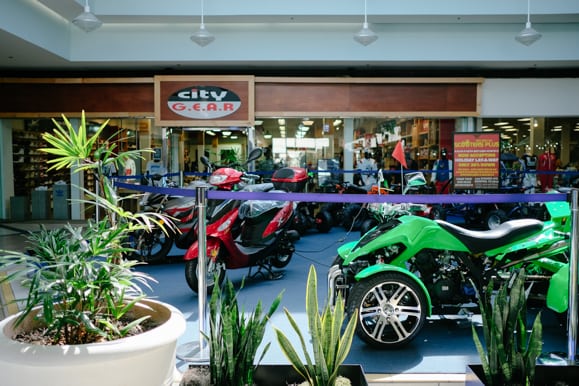 A Scooters Plus display in the Southland Mall. Located in Whitehaven since 1966, it is the oldest operational mall in Memphis. (Brandon Dahlberg)
A Scooters Plus display in the Southland Mall. Located in Whitehaven since 1966, it is the oldest operational mall in Memphis. (Brandon Dahlberg)
For everything that Whitehaven seems to lack, there are strong neighborhood anchors such major tourist attraction Graceland and proximity to the Memphis International Airport.
Gracelandis thesecond most visited home in America, second only to the White House. Robertson said that with over 60,000 people visiting the area each year, there is a need for amenities not only for residents but for tourists.
“A Starbucks would kill here. Folks print Elvis signs and stuff all year long; a FedEx Kinko’s would kill, but nobody thinks about that,” Robertson said.
Robertson believes businesses moved away because they knew Whitehaven residents would cross the border to Southaven, which limited immediate options for the neighborhood residents.
“That disrespect and disregard bothers me. I personally as a 65-year-old black man, know it’s no accident. This is very intentional. It’s not about the business not being there; it’s about you don’t want to be here based on the race.”
The Developer: Potential for Whitehaven
Shawn Massey, partner with The Shopping Center Group, agreed that white flight is part of the reason for the retail exodus to Southaven. He also sees that lack of maintenance on available property in Whitehaven fails to attract new retailers.
Massey, who has been working in Whitehaven for more than 25 years, observed that the Mississippi cities of Southaven and Horn Lake have benefitted from white flight even though the cities are 50 percent black.
“Thesame reason some white people moved, was the same reason some black people moved —cheaper taxes and the perception of better schools,” Massey said.
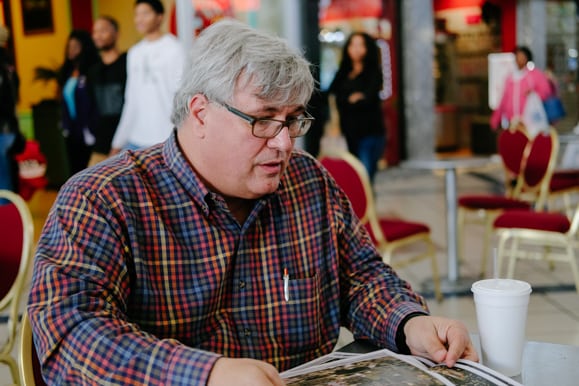 Shawn Massey, partner with The Shopping Center Groups, reviews maps of Whitehaven at the Southland Mall. (Brandon Dahlberg)
Shawn Massey, partner with The Shopping Center Groups, reviews maps of Whitehaven at the Southland Mall. (Brandon Dahlberg)
Retailers, he said, followed where they thought their customers were going and were also lured by advantageous Mississippi tax breaks.
“Businesses could move down there and they could build new buildings, find land and it was cheaper on taxes. Economically, it’s cheaper in Southaven and Horn Lake to run a restaurant than in Whitehaven because of real estate taxes alone. Our taxes are way too high,” Massey said. “Industry went down there because it was cheaper on taxes and you can get incentives.”
The median household income in Southaven is a little more than $58,000, which is approximately $19,000 more than in Whitehaven’s ZIP 38116. In Horn Lake, the median income is just over $45,000, which is $6,000 more than ZIP 38116.
One of the biggest reasons Massey feels that retailers left, in addition to the demographic changes, was because property owners would not reinvest in their properties. He said they were doing just enough to keep tenants in the buildings and keep rent low.
“If you have a restaurant in your shopping center and the property owner is not keeping up the parking lot or the façade, what is the retailer supposed to do? Do they stay in the building or go to the new shopping center?,” he said of Mississippi’s appeal.
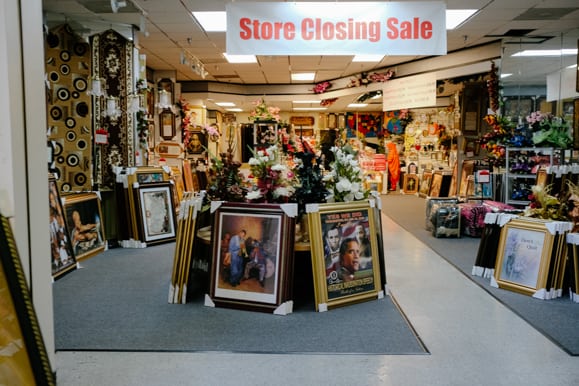 The entrance to T.J. Gifts and Fashion at the Southland Mall in Whitehaven. The store will soon be closing its mall location. (Brandon Dahlberg)
The entrance to T.J. Gifts and Fashion at the Southland Mall in Whitehaven. The store will soon be closing its mall location. (Brandon Dahlberg)
The Whitehaven retail market, Massey said, has a lot of potential for redevelopment because the population density is stable and not likely to shift too much.
He recentlyhelped develop Whitehaven Village, a 12,000 square foot shopping center on Elvis Presley Boulevard just north of Shelby Drive. Not including the land, the project cost $2 million. Whitehaven Village opened in 2017 and is 100 percent leased. It houses businesses such as locally-owned BeLeaf Cigars.
Related: “Success is smoky for brothers growing cigar business in Whitehaven”
“We showed that by building Whitehaven Village, that a new center would attract new investment and would attract new retailers that are national in scope to come to Whitehaven that did not want to go into a second or third or fourth generation space. They wanted to go into something that they would get in the suburbs,” Massey said.
The Mall: Keeping Up With the Population
For the past 15 years Micheal Rixter has been the manager of Southland Mall which opened in 1966 and is the oldest remaining mall in Memphis.
The predominance of black people in Whitehaven has shifted the customer base of the mall so that Southland is now considered an “urban mall,” which, Rixter has used in his favor to keep the building occupied and thriving.
“It is defined simply by what people buy in here. People buy urban wear, hip hop clothing, jeans, tennis shoes and athletic shoes. It’s big with our demographic,” he said.
The mall, Rixter said, is 68 percent occupied and will grow to more than 70 percent occupied in May with the opening of a 10,000-square-foot Shoe Show Mega Store. The store will be housed in the former Piccadilly space in the mall and feature men, women and children’s shoes.
Originally from South Memphis, Rixter left Memphis for college. When he returned, he took jobs at staffing companies, marketing companies and became an entrepreneur. Eventually, his career path led him to Southland Mall.
“When I got the job here, that immediately put me in a situation where I was married to Whitehaven and at that point, I had been gone from Memphis for so long, I didn’t know a lot about what was really going on in Whitehaven other than Elvis and the fact that white flight from Whitehaven had led to all of these properties and houses in Whitehaven available for African-Americans,” he said.
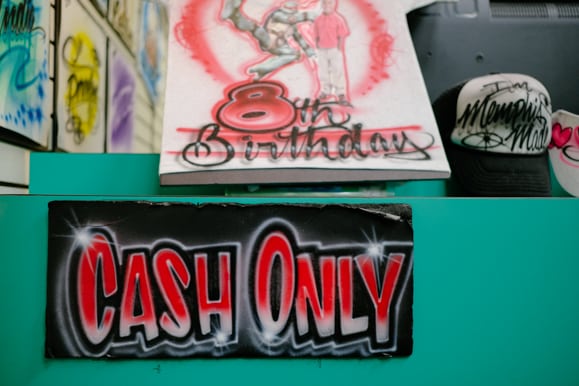 It’s cash only at Air Kingz Custom Airbrushing at the Southland Mall. (Brandon Dahlberg)
It’s cash only at Air Kingz Custom Airbrushing at the Southland Mall. (Brandon Dahlberg)
“I know the African-American growth had taken off to the point that I was shocked when a friend of mine told me it was nicknamed Blackhaven.”
Over the past 15 years, Rixter has worked diligently to increase and maintain occupancy at the 760,000-square-foot mall.
He said when he started, the mall was at 56 percent occupancy and some stores did not survive because they did not cater to the urban market. Others closed because of financial problems.
“I was a part of bringing in a lot of the stores that matched our demographic … bringing in stores that do not match the demographic is a design opportunity for failure. We used to call it bringing in the right family members here,” he said.
Just as the mall was experiencing an upswing in 2015, something drastic happened. Macy’s, one of the mall’s two anchor stores, closed. It was one of 24 that shuttered around the country at the time because of poor sales.
Rixter said the remaining anchor store for the mall, Sears, suffers in the clothing department because the clothes do not target the mall’s demographics, but survives because they are one of two Sears left in Memphis and people loyal to the brand still shop for the store’s appliances.
Currently, 30 percent of Southland’s stores are national chains, like Footlocker and Foot Action; 20 percent of the stores locally owned and the remaining are “ma and pa” stores and kiosks.
Rixter said the addition of sit-down restaurants in Whitehaven would help traffic in the all because studies show that people like to eat and shop.
“Watching the mall change over the past 15 years has been an incredible, joyous experience for me. To walk out of the management office and into the mall proper and see stores that are here because of my hard work for a plan that we have lived out has been exciting,” he said.



